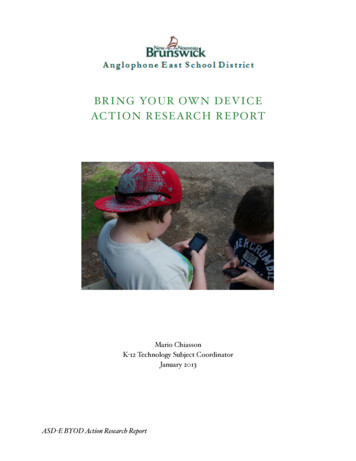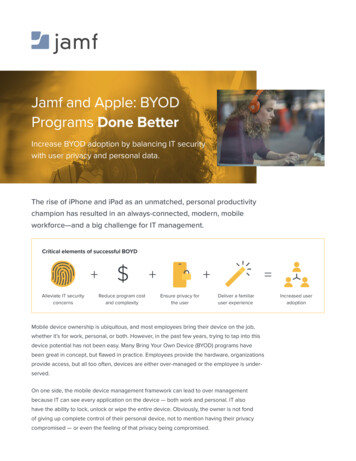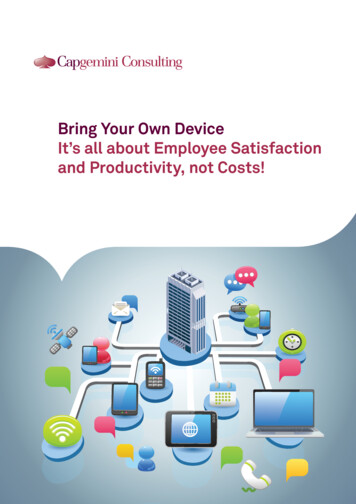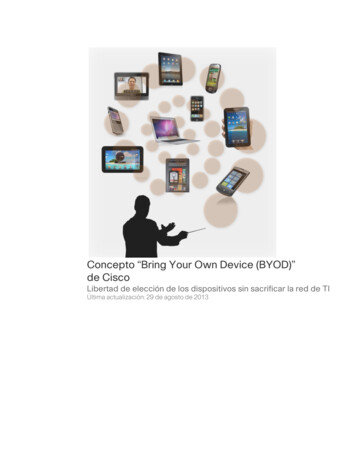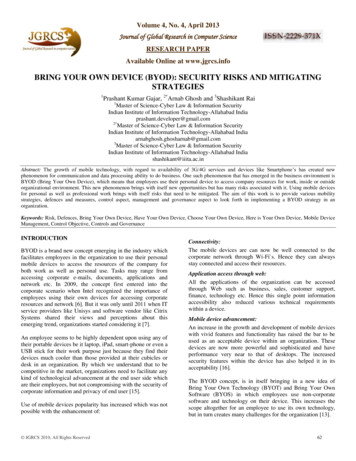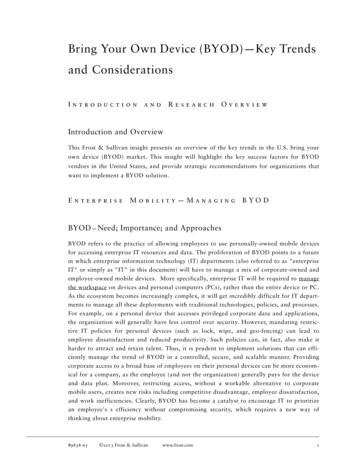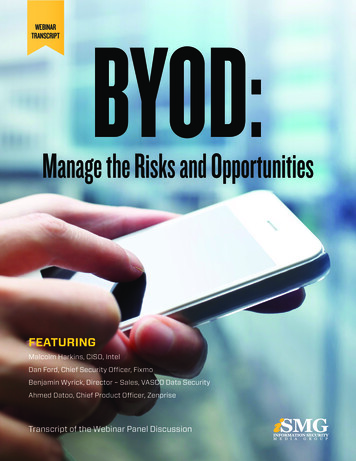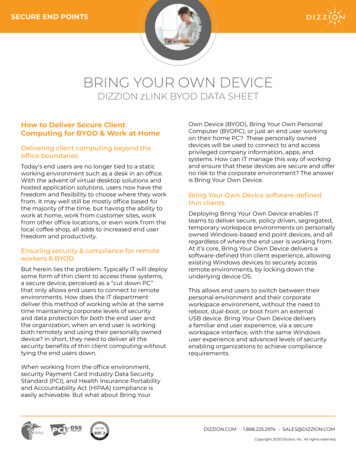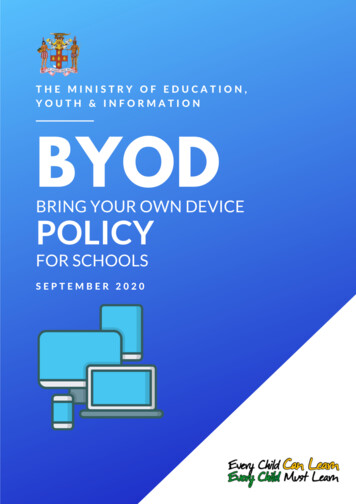
Transcription
Bring Your Own Device (BYOD) Policy – v.1.01
TABLE OF CONTENTSINTRODUCTION . 4SECTION 1 - POLICY FRAMEWORK . 6AIM . 6GUIDING PRINCIPLES . 6OBJECTIVES. 6LINKAGES WITH OTHER POLICIES . 6SECTION 2 – SCHOOL READINESS TO INTRODUCE BYOD . 7WHY BYOD? . 8POTENTIAL CHALLENGES OF BYOD . 8SECTION 3 – APPROVED DEVICES AND INSTITUTION REQUIREMENTS . 9APPROVED DEVICE REQUIREMENTS: . 9SCHOOL INFRASTRUCTURE REQUIREMENTS: . 10SCHOOL HUMAN RESOURCE REQUIREMENTS: . 11SECTION 4 – GENERAL GUIDELINES FOR ACCEPTABLE USE . 11GUIDELINES FOR THE CLASS SETTING: . 11GUIDELINES FOR STUDENTS AND FAMILIES . 12PERMITTED USE. 12PROHIBITED USE. 12NO EXPECTATION OF PRIVACY . 13MONITORING SOFTWARE . 13SECTION 5 – CONSEQUENCES FOR DISRUPTION AND MISUSE . 13SECTION 6 – SCHOOL LIABILITY STATEMENT . 14SECTION 7 – STAKEHOLDER ROLES AND RESPONSIBILITES . 14SECTION 8 – MONITORING AND EVALUATION . 18ACRONYMS . 19GLOSSARY . 20APPENDIX 1 . 22FORM 1. 22Bring Your Own Device (BYOD) Policy – v.1.02
BRING YOUR OWN DEVICE (BYOD) AGREEMENT AND ACCEPTABLE USE POLICY (AUP) FORPOST-PRIMARY EDUCATIONAL INSTITUTIONS . 22FORM 2. 28BRING YOUR OWN DEVICE (BYOD) AGREEMENT AND ACCEPTABLE USE POLICY (AUP) FOR[NAME] INFANT AND PRIMARY SCHOOL (THE SCHOOL) . 28APPENDIX II . 31CHILD ONLINE PROTECTION (COP) PROTOCOLS. 31REFERENCES: . 34Bring Your Own Device (BYOD) Policy – v.1.03
BRING YOUR OWN DEVICE (BYOD) FOR LEARNING POLICYINTRODUCTIONTechnology impacts everything we do in our daily lives. It is without a doubt that there aresignificant gains to be realised by embracing technology and its application to instructionaldesign and delivery. Globally, educators have developed innovative approaches to theintegration of new and existing technologies in the classroom with the sole objective ofenhancing the student learning experience.In 2014, the Ministry of Science, Energy and Technology (MSET) through the e-LearningJamaica Company (e-LJam) collaborated with the Ministry of Education, Youth & Information(MoEYI) to implement the Tablets in Schools (TIS) pilot project. This initiative was establishedwith the objective of improving the educational levels of Jamaicans in an effort to stimulate afully connected and knowledge-based society. The lessons learnt from the TIS pilot projectwas used to inform the Tablet in Infant and Primary Schools (TIIPS) initiative that will see theroll out of tablets to infant and primary schools in 2020.Despite the significant gains realized by the TIS initiative, it is concluded that the continuedprovision by the Government of Jamaica (GoJ) of one-to-one devices to students isunsustainable. As a result, in addition to providing select institutions with class set (s) to usein a shared manner, the MoEYI seeks to explore the possibility of a Bring Your Own Device(BYOD) approach for Jamaica’s education sector.For the purposes of this Policy, BYOD refers to the permitted use of an approved privateportable computing device (for example, a laptop, tablet, smartphone etc.) by a student atschool or on the school’s network in furtherance of the student’s learning. Access to theSchool Network may be at no cost to students and their families. Students participating in aBYOD programme can use their own devices (BYO Devices) as an alternative to, or as anadditional level of support to devices provided by the Government/school (Class set Devices).Learning activities utilizing BYO devices can take place both on-line, typically by connecting tothe school’s network; or off-line, for example, utilizing materials that have been downloadedto the BYO Device.The MoEYI is aware that some schools have already begun to implement aspects of a BYODapproach to support the demand by students and teachers for the use of InformationCommunication Technologies (ICTs) in the teaching learning process. These initiatives rangefrom informal or ad hoc use by some teachers to a strictly controlled whole-school approach.The concept of ‘mobile learning’ has come into sharp focus with the declaration by the WorldHealth Organization (WHO) of the Coronavirus disease (COVID-19) Pandemic on March 10,2020. Countries across the world including Jamaica responded by closing all schools, amongBring Your Own Device (BYOD) Policy – v.1.04
other social distancing measures meant to control the spread of the Virus. In order to ensurethat learning continues in the face of physical school closures, may schools resorted toutilizing various distance education modalities, including on-line learning. This latestdevelopment has seen a surge in the number of children joining the online world for the firsttime to support their studies and maintain social interaction.When schools do re-open, it is anticipated that mixed modalities of instruction will be neededto ensure adherence to prevailing public health requirements. As we look to the future, it isclear that education as we know it in our school system will undergo a paradigm shift - one inwhich ICT enabled learning can no longer be considered optional.Based on the foregoing, there is now an urgent need for coherent policy direction from theMoEYI to guide the adoption of the BYOD approach in Jamaica’s school system. Consequently,this document contains the national framework that will govern the BYOD approach forlearning for implementation in all schools.This Policy is organized in seven (7) sections as follows:Section 1.Policy FrameworkSection 2.Evaluating School Readiness to Introduce BYODSection 3.Approved Devices & Institution RequirementsSection 4.General Guidelines for Acceptable UseSection 5.Consequences for Disruption and MisuseSection 6.Institution LiabilitySection 7.Stakeholder Roles and ResponsibilitiesA Glossary of technical terminology (Page 18) is included at the end of the Policy. Also includedare templates for a School BOYD Agreement (containing an Acceptable Use Policy), which maybe used or modified to reflect each school’s circumstances (Appendix I). Finally, the MoEYI’sChild Online Protection (COP) Protocols is contained in Appendix II.Bring Your Own Device (BYOD) Policy – v.1.05
SECTION 1 - POLICY FRAMEWORKAIM1.1 This BYOD policy provides the background, rationale and general guidelines for schools(early childhood to secondary school level) seeking to implement a BYOD programme. TheBYOD policy is intended to work in conjunction with school-based policies and procedures.The policy guidelines will support schools, to enable students to bring their owntechnology and devices to school solely for the purpose of enhancing the learning process.GUIDING PRINCIPLES1.2 The guiding principles of the BYOD Policy are: Security and Safety Inclusion and Participation Sustainability – Learning for the futureOBJECTIVES1.3 The objectives of the BYOD Policy are to: Transform the ways in which teachers deliver their lessons by creating an educationalsystem in which facilitators use ICTs in the teaching and learning environment toencourage learning and improve students’ performance while effectively managing ofthe learning process. Transform the learning process by integrating ICTs within the curriculum and duringassessments, encourage critical thinking, problem-solving, decision making and digitalcitizenship inclusive of the values inherent in collaborating and communicatingthrough the integration of ICTs in the education system.LINKAGES WITH OTHER POLICIES1.4 The policy supports the United National Sustainable Development Goals, and in particularto ensure inclusive and equitable quality education and promote lifelong learningopportunities for all.Bring Your Own Device (BYOD) Policy – v.1.06
1.5 The Policy was developed to align with the standards for students outlined in the 2016International Society for Technology in Education (ISTE) which highlight the followingcritical attributes for a 21st- century student: Empowered LearnerResponsible Digital CitizenKnowledge ConstructorInnovative DesignerComputational ThinkerCreative CommunicatorGlobal Collaborator1.6 Additionally, the Policy is aligned with recent guidance provided by the InternationalTelecommunications Union (ITU) for CPO, which aims to provide a safe, age-appropriate,inclusive and participatory digital space for children and young people.1.7 Nationally, the Policy supports Jamaica’s National Development Plan, Vision 2030, and inparticular, Goal 1: Jamaicans are Empowered to Reach their Fullest Potential which isaligned to National Outcome 2: World-Class Education and Training; and NationalOutcome 11: A Technology-Enabled Society.1.8 The Policy is consistent with national policies and legislation to promote a modern ICTframework. Sector-wise, the Policy is aligned to proposals being pursued by the Ministryunder its draft ICT in Education Policy, the goals of which are: learning opportunities for all transforming the Teaching and Learning Process efficient management and administration of the Education System promoting the development of ICT Innovations.SECTION 2 – SCHOOL READINESS TO INTRODUCE BYOD2.1 This section recognizes that each school’s situation is unique. The benefits and challengesof introducing BOYD to the school must be carefully considered and consultationundertaken before a decision is made. Implementing a BYOD approach to learning is aschool-based decision that must be undertaken in consultation with and supported bythe MoEYI and stakeholders.Bring Your Own Device (BYOD) Policy – v.1.07
WHY BYOD?2.2 Research has shown that the use of portable computing devices such as tablets andlaptops can enhance the teaching the learning process. For example, it can supportstudent-centred learning where students assume greater responsibility for their ownlearning. In turn, student self-directed and active learning can lead to higher levels ofmotivation and engagement by students. Additionally, the use of devices facilitatesdifferentiated instruction within classes in which students can engage with class activitiesat their own pace, using their personal approach.2.3 A BYOD programme can enhance these benefits having regard to the following: By enabling students who have access to a BYO Device, the school can more effectivelyallocate Class Set Devices to students who need them, thereby maximizing studentparticipation in ICT-enabled learning.Students may prefer to use technology and devices with which they are familiar, anda BYOD programme allows them to do so for educational purposes.Students are more likely to take proper care of their personal property.POTENTIAL CHALLENGES OF BYOD2.4 Examples of some of the potential challenges that schools may identify in their planningprocess are: worries about human resource capacity and additional workloadworries about infrastructural capacity and the risk to security of the school’snetworkensuring equitable access by students to educational technologyconcerns about student safety on-line2.5 Assisted by MoEYI, some of the key questions to be considered by the school in the BYODplanning stage are set out in the table below. BroadbandType of broadband connectionavailable?Total broadband currently available?Option to upgrade?Strategies for sharing connection andbandwidth? Devices and Device ManagementTypes of devices to be allowed (seeSection 3)?Total number of devices expected?Device management processes andsystems needed (See Section 4)?Bring Your Own Device (BYOD) Policy – v.1.08
Wi-Fi NetworkWi-Fi infrastructure currently installed?Use and performance of current Wi-Fi?Who will do sit survey/networkoptimisation?Requirements indicated by site surveyType/capacity of existing and requiredAccess Points?Positioning of new Access PointsIT SupportWhat IT support will students beoffered?What will be handled in school/region?Training required?What services can be outsourced? Network UseWhere and when will devices be used?How often will devices be used?Amount of video streaming expectedAmount of data uploading expected?Access ControlHow will user identity be authenticated?Device screening and authenticationmethods?What services/applications/materialscan users access?Will access to some applications berestricted?SafeguardingContent filtering strategies and tools(See Appendix 2)?How will acceptable use policy bedeveloped (See Section 3)Adapted from: “BYOD for Schools: Technical advice for school leaders and IT 753/817341/BYOD Technical guide full v7.pdfSECTION 3 – APPROVED DEVICES AND INSTITUTIONREQUIREMENTSAPPROVED DEVICE REQUIREMENTS:3.1 Stipulating technical specifications for BYO Devices ensures that all students have thesame or similar devices and therefore learning experience. Standardization has bothpedagogical and technical benefits, making the work of teachers easier and simplifying ITsupport. Upon the completion of a comprehensive and careful evaluation (See Section 2),schools may recommend specific devices for use in the enhancement of the learningprocess. These devices may include: laptopsnetbookstablet computersmobile phonesvirtual and augmented reality headsetsBring Your Own Device (BYOD) Policy – v.1.09
3.2 The recommendation of approved devices should take into consideration the suitabilityof the device for educational enrichment, and all aspects of the device’s technicalspecifications such as make, model, operating systems, storage, screen size, andprocessor. The diagram below illustrates some of the factors affecting approved BYODevice requirements.Source: http://www.eun.org/documents/411753/817341/BYOD Technical guide full v7.pdf3.3 For the preparation of use, all BYO Devices should be fully charged before school each dayand have its software (Operating System and Antivirus and Malware Protection Software)updated when necessary.SCHOOL INFRASTRUCTURE REQUIREMENTS:3.4 Each school is required to have the necessary infrastructure which will facilitate a stablepower supply from the local grid. A stable power supply is critical to the functioning ofequipment such as wireless routers, hubs, and local file servers.3.5 All schools will be required to establish appropriate Wireless Local Area Networks(WLAN) with designated WI-FI Hotspots. Each Hotspot will facilitate Role-Based AccessControl protocols. Students, teachers, and school administrators may be given designatedusernames and passwords which will provide network access in accordance with the limitsand rights assigned to each group.3.6 Each school is required to ensure adequate cyber security measures are in place to:Bring Your Own Device (BYOD) Policy – v.1.010
protect the school network from unauthorized access and other risks; andsafeguard students from inappropriate content and communication. A COP Protocol(Appendix 2) has been developed by the MoEYI and must be adhered by all schools.SCHOOL HUMAN RESOURCE REQUIREMENTS:3.7 Teachers and select faculty members must be sufficiently trained in relation to thefollowing: new approaches relating to BYOD classroom management strategies.providing basic in-class technical support to students.technical support in relation to student device and school WLAN functionality.SECTION 4 – GENERAL GUIDELINES FOR ACCEPTABLE USEThis section addresses the stakeholder code of conduct, and development of stakeholdersas responsible digital citizens.GUIDELINES FOR THE CLASS SETTING:4.1 Class teachers may invite students to bring BYO Devices to class, on designated days andfor specific educational purposes in accordance with the School’s BYOD Policy. BYODevices, as opposed to Class Set Devices where they exist, are not to be utilized for generaluse by students. Opportunities for use of BYO Devices may vary from class to class basedon units of study, appropriateness of certain tools, age, and experience of students.4.2 The use of personal devices in classrooms should be carefully planned, guided, andsupported by teachers. Such use may include: carrying out online research creation of multimedia content such as videos, audio etc. commenting on blogs adding content to websites participating in online discussions word processing4.3 Each teacher has the discretion to allow and regulate the use of BYOD in theclassroom and on specific projects.Bring Your Own Device (BYOD) Policy – v.1.011
4.4 Teachers should adhere to staff polices governing interaction with students,particularly outside of scheduled classes/activities and when using social media,messaging apps and email.GUIDELINES FOR STUDENTS AND FAMILIES4.5 Students and parents participating in the BYOD programme must adhere to the school’sBYOD Policy, BYOD Agreement and/or Acceptable Use Policy (AUP). A BYOD AgreementTemplate, containing an AUP, is appended to this Policy (Appendix 1) and can be used ormodified by schools to support their own situation. This or other similar Agreements mustbe read, signed, and returned to the school office as a condition for participating in theBYOD programme.PERMITTED USE4.6 The primary use of BYO Devices at school or on the school’s network is for educationalpurposes. Use of BYO Devices at school or on the school’s network should therefore belimited to support classroom instructional delivery and other approved school activities.For these purposes, student may use the School wireless network and content Filteredbroadband. Use of other unfiltered public wireless connections, such as mobile networks,is not allowed during school hours. Students should only access digital content onwebsites which are relevant to the classroom curriculum.4.7 BYO Devices brought onto school grounds should be labelled for identification and loggedin daily and given a unique reference number. BYO Devices should be charged prior toschool and run on battery power while at school. Charging of BYO devices on schoolproperty may be permitted in the sole discretion of authorized school personnel. BYODevices should be kept in silent mode while on school premises unless authorised by ateacher. Headphones may be used with the permission of a teacher. Permission shouldbe sought before attaching any school property to a BYO Device. If a BYOD Device has acamera and/or video capability, these must be disabled whilst at school or during schoolhours, unless the capability is genuinely required in connection with authorized learningactivities. This ensures that the privacy of the user and other students is not inadvertentlybreached by the capture and dissemination of images.PROHIBITED USE4.8 BYO devices should not be used as an aid in the dishonest completion of exams,assignments, or quizzes. Students should not use BYO Devices to record, transmit, or postphotographic images or video of a person or persons on campus during school hours orduring school activities unless authorised by a teacher.Bring Your Own Device (BYOD) Policy – v.1.012
4.9 Students and Parents/Guardians must be made aware and acknowledge that the school’snetwork filters will be applied to a BYO device’s connection to the internet and anyattempt to bypass the network filters is prohibited. The school’s BYOD Agreement and/orAUP should prohibit students from: brining a device on premises that infects the network with a Virus, Trojan, orprogram designed to damage, alter, destroy, or provide access to unauthorizeddata or information; and altering, hacking or attempting to bypass the school’s network security systems.NO EXPECTATION OF PRIVACY4.9.1 It is also important for students and parents to acknowledge and accept that the useof a BYO Device on the School’s network or while at School is not private. The BYOAgreement and/or AUP should provide that the school may, without prior notice, log,supervise, access, view, monitor, and record use of student devices on the school’snetwork or while on school campus at any time for any reason related to the operationof the school.4.9.2 The BYOD Agreement and/or AUP should provide that devices may be subject tosearch and temporary seizure by school administrators where it is reasonablysuspected that a violation of the following has occurred: school’s Student Code of Conduct or Student Handbookschool’s BYOD Policy, BYOD Agreement and/or school’s AUPany relevant law or regulationsMONITORING SOFTWARE4.9.3 The MoEYI supports the use of Monitoring Software to ensure COP and adherence tothe school’s BYOD Policy, BYOD Agreement and/or AUP. The school’s BYODAgreement should specify that schools may use monitoring software to enable theviewing of the screens and activity on BYO devices while on the school’s network oron school premises.SECTION 5 – CONSEQUENCES FOR DISRUPTION AND MISUSE5 Existing Student Codes of Conduct and Student Handbooks should be revised to ensureprovision is made for actions to be taken against students who breach the school’s BYODBring Your Own Device (BYOD) Policy – v.1.013
Policy, BYOD Agreement and/or AUP as appropriate in the circumstances. Recommendedactions based on severity and number of breaches include: parents notified of the breach. BYO Device taken away for a stipulated period. BYO Device taken away and kept in the administrative office until a parent collectsit. Restrictions in participation in BYOD programmeTemporary or permanent exclusion from the BYOD ProgrammeSECTION 6 – SCHOOL LIABILITY STATEMENT6 Students bring their own devices to school at their own risk. It is the duty of the studentsto be responsible for the upkeep and protection of BYO Devices, including the use ofprotective/carrying cases and up-to-date anti-virus and malware protection software.The school’s BYOD Agreement should clearly stipulate that the school is not liable for: BYO Devices that are damaged while at school or during school-sponsoredactivities.BYO Devices that are lost or stolen at school or during school-sponsoredactivities.maintenance or upkeep of any BYO Device (keeping it charged, installing updatesor upgrades, fixing any software or hardware issues).SECTION 7 – STAKEHOLDER ROLES AND RESPONSIBILITES7 To ensure sustainability and guarantee the success of the BYOD programme it isimperative that all stakeholders understand and accept their roles and responsibilities.A. The Ministry ofEducation Youth &Information isresponsible for: developing, monitoring, evaluating, and reviewing theBOYD Policy to ensure a flexible and user-friendly nationalframework which supports the implementation ofeffective BYOD programmes in schools. consulting with the Information CommunicationsTechnology Authority (the ICTA) on the applicability of anydirectives, codes, standards, and guidelines issued by theICTA that may be relevant to the BYOD Policy framework. ensuring schools adhere to the BYOD Policy framework intheir implementation of school BYOD programmes,particularly the principles of inclusion and participation, toBring Your Own Device (BYOD) Policy – v.1.014
ensure that students and families who wish to take part ina BYOD programme are not confronted with unrealisticexpectations. ensuring that schools are familiar with any ICTA directives,codes, standards and guidelines and adhere to them. ensuring that schools plan for the use of BYOD in theclassroom to support learning. support schools and families to plan for the creation of asafe and empowering on-line environment for children,including the identification of keys risks and harms forchildren on-line and the development of effectivemeasures for child online protection.providing students on government supported programmessuch as PATH access to devices for educational use.B. MoEYI & e-LJam areresponsible for: providing technical support for Class Set Devicespurchased by the GoJ and managed by the MoEYI forstudent use. providing support with wireless connection technicalissues, such as to ensure that all student devices canreadily connect to the school’s network.C. The Boards ofManagement (SchoolBoards) of Schools areresponsible for: in consultation with the MoEYI, overseeing theimplementation and operation of the school’s BYODprogramme and for this purpose, appointing a BYODSchool Board committee or delegating the responsibility ofBYOD to an existing School Board committee. ensuring engagement with various stakeholdersrepresented on the School Board prior to and throughoutthe implementation of a BYOD programme in the school. critically reviewing and approving school-based BYODpolicies and procedures, including the School’s BYODPolicy, the BYOD Agreement and or /AUP, revisions to staffand student codes of conduct and/or Handbooks, andother associated procedures and documents.D. Principals and otherschool administratorsare responsible for: ensuring engagement with parents and staff, through theirSchool Associations, prior to the implementation of aBring Your Own Device (BYOD) Policy – v.1.015
BYOD programme in the school and throughout itsoperation. developing standard operating procedures for approval bythe School Board to govern the school’s BYOD programme,including the school’s BYOD Policy, BYOD Agreementand/or AUP ensuring the MoEYI’s COP Protocols are in place. revising school polices to include student codes ofconduct, student handbooks, staff policies, complaintsprocedures and child protection reporting procedures forapproval of the School Board to ensure that these policiesand procedures address assessed risks associated withimplementing a BYOD programme. ensuring the school provides the necessary ICTinfrastructure including wireless access points that supportstudent devices connecting to the school’s Wi-Fi network. conforming with any ICTA directives, codes, standards andguidelines and co-operating with any ICTA authorized ICTaudit. including the BYOD approach for learning in educationalplanning and teacher and staff professional learningactivities. registering BYO Devices and assigning usernames andpasswords after receiving duly signed BYOD Agreementand/or AUP or similar documentation. offering parents, guardians and teachers support to betterunderstand online risks and harms for students, forexample, by providing Tips on online safety.E. Teachers are responsible providing guidance for use of ICT within the classroom andfor:associated learning environments, including ensuringstudents understand and follow the school’s BYOD Policy,BYOD Agreement and/or AUP and associated proceduresand documents. delivering curriculum and learning activities that usetechnology to build knowledge, understanding andproduce outcomes that are not possible or practicalwithout the use of technology.Bring Your Own Device (BYOD) Policy – v.1.016
ensuring the technology available to all students isconsidered when developing curriculum and learningactivities. planning for the use of a BYOD approach to learning in theclassroom through the National Standards Curriculum(NSC). ensuring that Cyber Safety is a key component of ICTbased teaching and learning and that the MoEYI’s COPProtocols are observed. ensuring that all interaction with students outside ofscheduled classes/activities for example via social m
in a shared manner, the MoEYI seeks to explore the possibility of a Bring Your Own Device (BYOD) approach for Jamaica's education sector. For the purposes of this Policy, BYOD refers to the permitted use of an approved private portable computing device (for example, a laptop, tablet, smartphone etc.) by a student at
